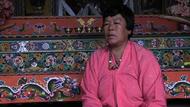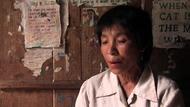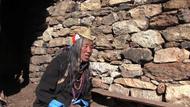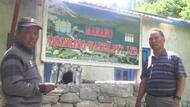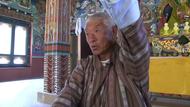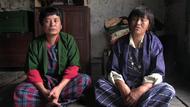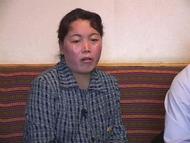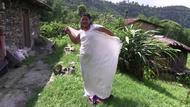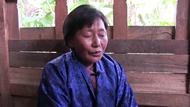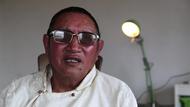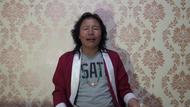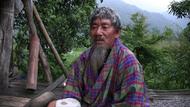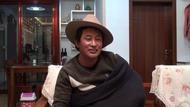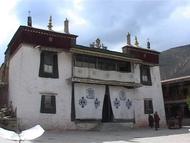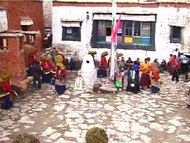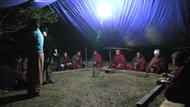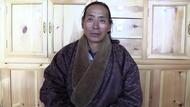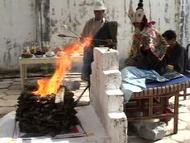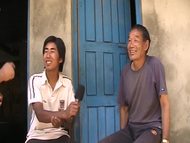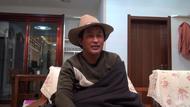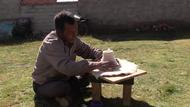Video Overview
A doctor introduces the dispensary of the Tibetan Medicine Factory.
- ཨེམ་ཆི་ལགསདེར་སྲོལ་རྒྱུན་གྱི་སྨན་གྱི་མཛོད་ཁང་རེད།This is the storage room for the traditional medicines.
- ཨེམ་ཆི་ལགསསྨན་གྱི་མཛོད་ཁང་དེའི་ནང་ལ་ཆ་བཞག་ན།For instance, in this storage room,
- ཨེམ་ཆི་ལགསབོད་སྨན་གྱི་སྣ་ཁ་༼སྣེ་ཁ་༽སུམ་བརྒྱ་བཅུ་གཉིས་ཙམ་ཡོད་རེད།there are about 320 kinds of Tibetan medicines.
- ཨེམ་ཆི་ལགསསུམ་བརྒྱ་གཅུ་གཉིས་དེའི་ནང་ལ་ཆ་བཞག་ན།Among these 320 medicines,
- ཨེམ་ཆི་ལགསསྨན་གཙོ་བོ་དེ་རིལ་བུས་གཙོ་བོ་བྱས་པའི།the majority are pills,
- ཨེམ་ཆི་ལགསདེ་ག་ནང་བཞིན་ཕྱེ་མ་ཡོད་རེད་འོང་་་ཐང་ཡོད་རེད།additionally there are powders and liquids.
- ཨེམ་ཆི་ལགསདེའི་ནང་ལ་ཆ་བཞག་ན།Concerning [the fact that]
- ཨེམ་ཆི་ལགསད་དེ་གས་སྨན་དེ་གས་གཙོ་བོ་དེ་ག་པ་ར་བཏང་གི་ཡོད་རེད་ཟེར་ན།where these medicines have mainly been used,
- ཨེམ་ཆི་ལགསབོད་ཀྱི་ཞིང་འབྲོག་ས་ཁུལ་ལ་ཡར།[they have been used] in the Tibetan rural areas.
- ཨེམ་ཆི་ལགསཞིང་འབྲོག་ས་ཁུལ་གྲོང་གསེབ་ཁག་ལ་ཡར།In the rural areas, these medicines have been mainly bought by
- ཨེམ་ཆི་ལགསགཙོ་བོ་ས་གནས་ཀྱི་སྨན་ཁང་།the prefectural hospitals,
- ཨེམ་ཆི་ལགསད་ག་ནང་བཞིན་གྱི་ཤང་གི་སྨན་ཁང་།the township clinics,
- ཨེམ་ཆི་ལགསགྲོང་ཚོའི་སྨན་ཁང་།the village clinics,
- ཨེམ་ཆི་ལགསད་ག་ནང་བཞིན་ཨེམ་ཆེ་རྐང་རྗེན་མ།as well as barefoot doctors.
- ཨེམ་ཆི་ལགསསོ་སོ་སྒེར་གྱི་སྨན་་་ཨེམ་ཆི་དེ་འདྲ་གི་ཉོས་བྱས་ད།There are also some private doctors who buy [the medicines] and
- ཨེམ་ཆི་ལགསནད་པར་དངོས་སུ་སྤྲད་ཀྱི་ཡོད་རེད།distribute to the patients.
- ཨེམ་ཆི་ལགསསྨན་དེ་གས་ལ་ཡར་ཁྱད་ཆོས་ག་རེ་ཡོད་རེད་ཟེར་ན།Regarding the characteristics of these medicines,
- ཨེམ་ཆི་ལགསདེང་དུས་ཀྱི་ཐུམས་བཀྲིས་བརྒྱབ་པའི་སྨན་དང་ཁྱད་ཆོས་མ་འདྲ་བ་ག་རེ་ཡོད་རེད་ཟེར་ན།which are different from the modern capsulations,
- ཨེམ་ཆི་ལགསགཙོ་བོ་དེ་ཞིང་འབྲོག་དམངས་ཚོགས་ཙར་འགྲོ་སའི་སྨན།these are medicines that can be consumed by [the people] in the rural areas.
- ཨེམ་ཆི་ལགསད་ག་ནང་བཞིན་ཁོ་ལ་ཡར་ཨང་དང་པོའི་ཁྱད་ཆོས་ག་རེ་ཡོད་རེད་ཟེར་ན།The most important aspect is
- ཨེམ་ཆི་ལགསཁོར་རིན་གོང་དམའ་པོ་རིན་གོང་འཚམས་པོ།that they are fairly cheap.
- ཨེམ་ཆི་ལགསད་ཉོ་དུས་ཙམ་ནས་རྒྱ་མ་བཀྱག་བྱས་འཁྱེར་ཕྱིན།One can buy such medicines according to the weights of the medicines,
- ཨེམ་ཆི་ལགསབདག་གཅེས་ཡག་པོ་བྱས།[These types of medicines] should be taken care of very well,
- ཨེམ་ཆི་ལགསབཞའ་ཚན་མ་ཕོག་པར་སྐམ་སར།kept in dry places.
- ཨེམ་ཆི་ལགསབོད་་་བོད་ནང་ལ་ཆ་བཞག་ན་ད།For instance in Tibet,
- ཨེམ་ཆི་ལགསའོང་་་ད་བཞའ་ཚན་དམའ་པོ་རེད་པཱ།it is not moist
- ཨེམ་ཆི་ལགསསྐམ་ས་རེད་པཱ།but dry.
- ཨེམ་ཆི་ལགསདེ་བྱེད་དུས་བོད་ནང་ལ་ཞིང་འབྲོག་ས་ཁུལ་ལ་ཆ་བཞག་ན།Therefore, in the rural areas of Tibet,
- ཨེམ་ཆི་ལགསཁོའི་ངོ་བོ་འགྱུར་ཡག་དང་གང་ཕྱིར་ཐོག་ལ་ཆ་བཞག་ན། ངེས་ཅན་གྱི་ཁྱད་ཆོས་ལྡན་བསྡད་པ་དེ་འདྲ་རེད།[this climate] is beneficial for protecting the medicines from becoming bad quality.
- ཨེམ་ཆི་ལགས་
- ཨེམ་ཆི་ལགསགལ་སྲིད་སྨན་དེ་འདྲས་རེ་ཞིག་ད་ཕྱིན་གྱི་སྨན་ནང་བཞིན་ཐུམས་སྒྲིལ་མ་རྒྱག་པར། རྒྱ་ནག་ལ་བཏང་པ་ཡིན་ན།If we sent such medicines to inner China without capsulation,
- ཨེམ་ཆི་ལགས་
- ཨེམ་ཆི་ལགསཨ་ནི་བདག་གཅེས་བྱེད་ཐུབ་ཡག་ཡོད་མ་རེད་པཱ།it is impossible to keep [the quality of the medicines]
- ཨེམ་ཆི་ལགསག་རས་ཟེར་ན་རྒྱ་ནག་བཞའ་ཚན་ཆེན་པོ་རེད་པཱ།due to the moist climate in China,
- ཨེམ་ཆི་ལགསདངོས་པོ་ངོ་བ་དང་དེ་གས་བཞའ་ཚན་དང་དེ་གས་འཁོར་ཡོང་དུས།where because of the nature of the [medicines] and moist climate,
- ཨེམ་ཆི་ལགསཁོ་ཧམ་སྤུ་བརྒྱབ་ཡག་ལ་སོགས་ཀྱིས་ངོ་བོ་དེ་གས་འགྱུར་འགྲོ་གི་རེད།[the medicines] will become moldy, and affect the quality of the medicines.
- ཨེམ་ཆི་ལགསད་དེའི་ནང་ལོགས་ལ་གཙོ་བོ་དེ་སྨན་སྣ་སུམ་བརྒྱ་ལྷག་ཙམ་་་་་།More than 300 kinds of medicines
- ཨེམ་ཆི་ལགསད་གཙོ་བོ་ཞིང་འབྲོག་དམངས་ཚོགས་ལ་ཞིང་འབྲོག་དམངས་ཚོགས་དང་།are mainly sent to the people in the rural areas,
- ཨེམ་ཆི་ལགསསྨན་ཁང་སྒེར་གྱི་ཨེམ་ཆི་དེ་གས་ལ་བཏང་བྱས།clinics, and private doctors.
- ཨེམ་ཆི་ལགསཐད་ཀར་ལ་ཡར་ཞིང་འབྲོག་དམངས་ཚོགས་ལ་ཞབས་འདེབས་ཞུ་ཡག་རྐྱང་རྐྱང་རེད།These medicines bring direct benefits to the people in rural areas.
- ཨེམ་ཆི་ལགསདེ་གས་ལ་ཆ་བཞག་ན། སྲིད་གཞུང་ནས་དེ་གས་ལ་དམིགས་གསལ་གྱི་བཀག་འགོག་བྱེད་ཀྱི་ཡོད་མ་རེད།The government has not made any special prohibition towards these medicines,
- ཨེམ་ཆི་ལགསམ་གཞི་ཁོར་ཡར་སྲིད་གཞུང་གིས་ཆོག་མཆན་ཨང་གྲངས་ཡོད་མ་རེད།although these medicines do not have registration numbers.
- ཨེམ་ཆི་ལགསབཀག་འགོག་བྱེད་ཀྱི་ཡོད་མ་རེད། རྒྱུ་མཚན་ག་རེ་རས་ཟེར་ན།The reasons why the government does not prohibit [such medicines] are
- ཨེམ་ཆི་ལགསབོད་་་་བོད་ཀྱི་ནང་ལོགས་ནས་ཆ་བཞག་ན་ད་ཞིང་འབྲོག་ས་ཁུལ་ལ་ཆ་བཞག་ན།in Tibet, particularly in rural Tibet,
- ཨེམ་ཆི་ལགསབོད་སྨན་ལ་ཧ་ཅང་དགའ་པོ་རེད།people love Tibetan medicines
- ཨེམ་ཆི་ལགསསྲིད་གཞུང་ནས་བོད་སྨན་ལ་ད་བརྩེ་དུང་དང་མ་སོང་ནས་མང་པོ་ཡོད་རེད་པ་ད།and the government also would like to show their affection towards Tibetan medicines.
- ཨེམ་ཆི་ལགསདེ་གས་ལ་ཆ་བཞག་ན་ད་ཐུམས་སྒྲིལ་བརྒྱབ་ཆོག་མཆན་ཨང་གྲངས་ཞུས་བྱེད་དུས།If the medicines are encapsulated and received registration numbers,
- ཨེམ་ཆི་ལགསགོང་ཚད་ག་རེ་ག་ཙམ་ལ་འཕར་འགྲོ་གི་རེད་པཱ།the prices for the medicines will increase accordingly,
- ཨེམ་ཆི་ལགསདེ་བྱེད་དུས་དམངས་ཚོགས་ཀྱི་ཆ་རྐྱེན་དང་བྱེད་བྱས། འོང་་་་དེ་ཉོ་མ་ཐུབ་པ་དེ་འདརས་ཡོང་གི་ཡོད་རེད།while the people in rural Tibet can not afford them because of their poor financial condition.
- ཨེམ་ཆི་ལགསབྱས་ཙང་སྔ་རྒྱུན་གྱི་རྒྱ་མར་བཀྱག་བྱས་མུ་མཐུད་ནས་འདུག་ཟེར་བཙོང་གི་ཡོད་རེད།Therefore, these medicines have been sold according to the weights [of the medicines] as it has been doing in the past.
 Loading ...
Loading ... 